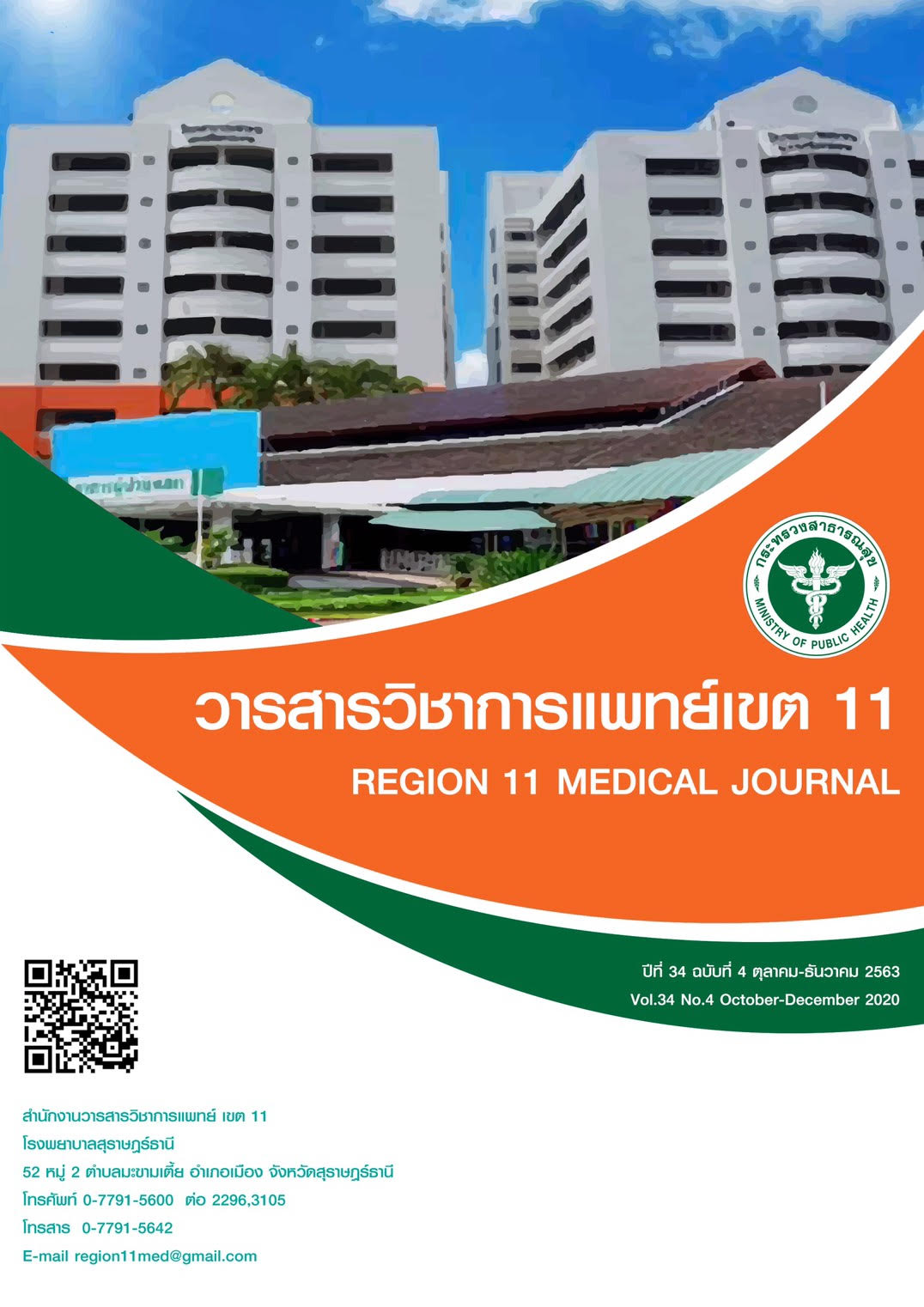ความสัมพันธ์ระหว่างขนาดต้อเนื้อกับค่าสายตาเอียงที่กระจกตาในผู้ป่วยที่เข้ารับการผ่าตัด ในโรงพยาบาลสิชล จังหวัดนครศรีธรรมราช
คำสำคัญ:
กระจกตา, ค่าสายตาเอียง, ต้อเนื้อบทคัดย่อ
ที่มา: โรคต้อเนื้อ เกิดจากความเสื่อมของเยื่อบุตาทำให้เยื่อบุตาเปลี่ยนแปลงไป มีเส้นเลือดมาเลี้ยงมากขึ้นและเจริญลุกลามเข้าไปในกระจกตา เกิดตามัวจากสายตาเอียง ส่งผลต่อการมองเห็นและการใช้ชีวิตประจำวัน
วัตถุประสงค์: เพื่อศึกษาความสัมพันธ์ระหว่างขนาดต้อเนื้อกับค่าสายตาเอียงที่กระจกตา และศึกษาขนาดของต้อเนื้อที่มีผลต่อการเปลี่ยนแปลงค่าสายตาเอียงอย่างมีนัยสำคัญหลังผ่าตัด
วิธีการศึกษา: เป็นการศึกษาเชิงวิเคราะห์ เก็บข้อมูลจากผู้ป่วยที่ได้รับการวินิจฉัยว่าเป็นโรคต้อเนื้อ และมารับการผ่าตัดที่โรงพยาบาลสิชล จังหวัดนครศรีธรรมราช ระหว่างเดือนมกราคม-ธันวาคม 2562 ผู้ป่วยจะได้รับการวัดขนาดต้อเนื้อ วัดค่าสายตาเอียงก่อนการผ่าตัด และหลังการผ่าตัดที่ 1 เดือน และ 3 เดือน นำข้อมูลที่ได้มาวิเคราะห์โดยใช้สถิติ Spearman rank correlation coefficient, Pair t-test และ Receiver Operating Characteristic (ROC)
ผลการศึกษา: การศึกษาครั้งนี้มีผู้ป่วยเข้าร่วมจำนวน 56 ราย เพศชาย 11 ราย (ร้อยละ 19.6) เพศหญิง 45 ราย (ร้อยละ 80.4) มีขนาดของต้อเนื้อที่วัดจากแนวแกนนอนจาก limbus เฉลี่ย 3.48 มิลลิเมตร พื้นที่ของต้อเนื้อเฉลี่ย 11.04 ตารางมิลลิเมตร และทำให้เกิดค่าสายตาเอียงเฉลี่ย 4.64 ไดออปเตอร์ นอกจากนี้ยังพบว่าขนาดพื้นที่ของต้อเนื้อมีความสัมพันธ์ทางบวกกับค่าสายตาเอียงก่อนผ่าตัดในระดับสูง (r=0.78) อย่างมีนัยสำคัญทางสถิติ (p-value<0.001) ค่าสายตาเอียงก่อนผ่าตัดและหลังผ่าตัดที่ระยะเวลา 1 เดือน และ 3 เดือน ลดลงอย่างมีนัยสำคัญทางสถิติ (p-value<0.001) และขนาดพื้นที่ต้อเนื้อที่มากกว่า 5.4 ตารางมิลลิเมตร (sensitivity ร้อยละ 89.5 และ specificity ร้อยละ 55.6) และขนาดต้อเนื้อที่วัดในแกนแนวนอนมากกว่าหรือเท่ากับ 2.70 มิลลิเมตร (sensitivity ร้อยละ 79.0 และ specificity ร้อยละ 55.6) จะเป็นค่าที่ทำให้ค่าสายตาเอียงลดลงหลังผ่าตัดได้มากที่สุด 2.01 ไดออปเตอร์
สรุป: ขนาดพื้นที่ของต้อเนื้อมีความสัมพันธ์ทางบวกกับค่าสายตาเอียง และการผ่าตัดต้อเนื้อจะช่วยลดค่าสายตาเอียงที่กระจกตาได้อย่างมีประสิทธิภาพ โดยพื้นที่ของต้อเนื้อมากกว่า 5.40 ตารางมิลลิเมตร และขนาดต้อเนื้อที่วัดในแนวแกนนอนมากกว่า 2.70 มิลลิเมตร จะทำให้มีผลต่อการลดลงของค่าสายตาเอียงได้มากที่สุด เป็นประโยชน์ให้จักษุแพทย์พิจารณาเลือกผู้ป่วยเข้ารับการผ่าตัด
เอกสารอ้างอิง
Young AL, Cao D, Chu WK, Ng TK, Yip YW, Jhanji V, et al. The evolving story of pterygium. Cornea. 2018;37:S55-S7.
Lin Y-H, Sun C-C, Yeung L, Yu Y-W, Sun M-H, Chen K-J. Epidemiologic study of pterygium in Taiwan. Japanese journal of ophthalmology. 2019;63(4):297-303.
Van Acker SI, Haagdorens M, Roelant E, Rozema J, Possemiers T, Van Gerwen V, et al. Pterygium Pathology: A Prospective Case-Control Study on Tear Film Cytokine Levels. Mediators of inflammation. 2019;2019.
Heindl LM, Cursiefen C. Pterygium. Etiology clinical aspect and novel adjuvant therapies. Ophthalmology. 2010; 107(6): 517-20.
Malozhen SA, Trufanov SV, Krakhmaleva DA. Pterygium: Etiology, pathogenesis, treatment. Vestnik oftalmologii. 2017;133(5):76.
Clearfield E, Muthappan V, Wang X, Kuo IC. Conjunctival autograft for pterygium. Cochrane Database of Systematic Reviews. 2016(2).
Levinger E, Sorkin N, Sella S, Trivizki O, Lapira M, Keren S. Posterior Corneal Surface Changes After Pterygium Excision Surgery. Cornea. 2020;39(7):823-6.
Bradley JC, Yang W, Bradley RH, Reid TW, Schwab IR. The science of pterygia. British journal of ophthalmology. 2010;94(7):815-20.
Gazzard G, Saw S, Farook M, Koh D, Widjaja D, Chia S, et al. Pterygium in Indonesia: prevalence, severity and risk factors. British Journal of Ophthalmology. 2002;86(12):1341-6.
Khan FA, Khan Niazi S, Khan DA. The impact of pterygium excision on corneal astigmatism. J Coll Physicians Surg Pak. 2014;24(6):404-7.
Altan-Yaycioglu R, Kucukerdonmez C, Karalezli A, Corak F, Akova YA. Astigmatic changes following pterygium removal: comparison of 5 different methods. Indian journal of ophthalmology. 2013;61(3):104.
Cajucom-Uy H, Tong L, Wong T-Y, Tay W-T, Saw S-M. The prevalence of and risk factors for pterygium in an urban Malay population: the Singapore Malay Eye Study (SiMES). British journal of ophthalmology. 2010;94(8):977-81.
Cardenas-Cantu E, Zavala J, Valenzuela J, Valdez-Garcia JE, editors. Molecular basis of pterygium development. Seminars in ophthalmology; 2016: Taylor & Francis.
Fonseca EC, Rocha EM, Arruda GV. Comparison among adjuvant treatments for primary pterygium: a network meta-analysis. British journal of ophthalmology. 2018;102(6):748-56.
Raiskup F, Solomon A, Landau D, Ilsar M, Frucht-Pery J. Mitomycin C for pterygium: long term evaluation. British journal of ophthalmology. 2004;88(11):1425-8.
Lubbad A, Giarmoukakis A, Skatharoudi C, Astyrakakis A, Siganos C. Long term results of pterygium excision using different surgical techniques: A retrospective study. J Clin Exp Ophthalmol. 2016;8:629.
Garg P, Sahai A, Shamshad MA, Tyagi L, Singhal Y, Gupta S. A comparative study of preoperative and postoperative changes in corneal astigmatism after pterygium excision by different techniques. Indian journal of ophthalmology. 2019;67(7):1036.
Lawan A, Hassan S, Ifeanyichukwu EP, Yahaya HB, Sani RY, Habib SG, et al. The astigmatic effect of pterygium in a Tertiary Hospital in Kano, Nigeria. Annals of African medicine. 2018;17(1):7.
Fernandes AG, Salomão SR, Ferraz NN, Mitsuhiro MH, Furtado JM, Muñoz S, et al. Pterygium in adults from the Brazilian Amazon Region: prevalence, visual status and refractive errors. British Journal of Ophthalmology. 2020;104(6):757-63.
Kampitak K. The effect of pterygium on corneal astigmatism. Journal of the Medical Association of Thailand=Chotmaihet thangphaet. 2003;86(1):16.
ณวพล กาญจนรัณย์, วชิรา สนธิไชย. ความสัมพันธ์ระหว่างขนาดต้อเนื้อกับค่าสายตาเอียงที่กระจกตา. วารสารจักษุธรรมศาสตร์. 2558;10(1):57-63.






